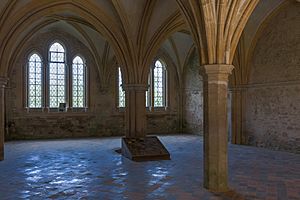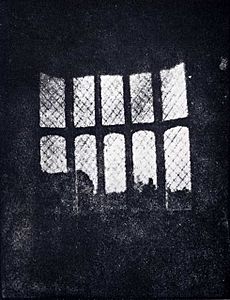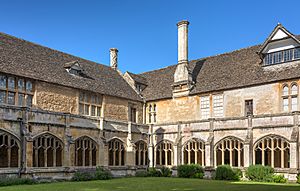Lacock Abbey facts for kids
Quick facts for kids Lacock Abbey |
|
|---|---|

Lacock Abbey from the south, including the window famously photographed by William Henry Fox Talbot
|
|
| Location | Lacock |
| OS grid reference | ST9193268418 |
| Area | Wiltshire |
| Built | 13th century |
| Rebuilt | 16th–-19th centuries |
| Owner | National Trust |
|
Listed Building – Grade I
|
|
| Official name: Lacock Abbey with stable yard | |
| Designated | 20 December 1960 |
| Reference no. | 1283853 |
| Lua error in Module:Location_map at line 420: attempt to index field 'wikibase' (a nil value). | |
Lacock Abbey is a super cool historic building in the village of Lacock, Wiltshire, England. It started out as a nunnery (a home for nuns) way back in the 1200s. A powerful woman named Ela, Countess of Salisbury, founded it.
Later, in the 1500s, the abbey changed a lot. It stopped being a nunnery and became a grand house for a family. Over the years, many people lived there, adding their own touches. This means the house looks like a mix of different styles and times!
One of the most famous people to live at Lacock Abbey was William Henry Fox Talbot. In 1835, he took what might be the oldest surviving camera negative ever! It was a picture of one of the abbey's windows. He was a pioneer in photography.
Today, Lacock Abbey belongs to the National Trust, a charity that looks after special places. You can visit the abbey and explore the Fox Talbot Museum inside. The museum celebrates William Talbot's amazing work in photography. It's a fantastic place to learn about history and how photography began!
Contents
A Look Back at Lacock Abbey's History
Lacock Abbey was founded in 1232 by Ela, Countess of Salisbury. She was a very important woman and the widow of William Longespee, who was the son of King Henry II. Ela herself joined the community of nuns in 1238.

The abbey did very well during the Middle Ages. It owned lots of rich farmland. This meant it earned a good income, especially from selling wool.
In the mid-1500s, King Henry VIII closed down many monasteries and abbeys. This event was called the dissolution of the monasteries. He sold Lacock Abbey to Sir William Sharington for £783. Sir William tore down the abbey church and used its stones to make the building bigger. He turned the nunnery into his family home around 1539.
Sir William made some cool additions. Around 1550, he built an eight-sided tower with two small rooms. One room was for keeping his treasures, and the other was for banquets. You had to walk across the roof to get to the banquet room!
The house later became home to the Talbot family. This is where William Henry Fox Talbot lived. In 1835, he took a picture of an oriel window in the abbey. This picture is thought to be the oldest surviving photographic camera negative! His experiments led to the invention of the "calotype" process, which made photography much easier.
During the English Civil War in the 1600s, the abbey was used as a fort by soldiers loyal to the King. It was surrounded by earth walls to protect it. However, it eventually surrendered to the Parliamentarian forces in 1645.
Exploring Lacock Abbey's Architecture
When Sir William Sharington bought the abbey in 1540, he built a country house on top of the old cloisters. He kept the cloisters and the medieval basement mostly the same. He then added another floor above them, so the main living rooms are on the first floor.
The house is made of stone, and its roofs are also made of stone slates. You'll see many cool, twisted chimney stacks from the 1500s. The abbey is a mix of different building styles because it was changed and added to over many centuries.

The basement has an arcade of cloisters on three sides. These surround several vaulted rooms, including the chapter house and a warming room. These rooms were once under the nuns' sleeping area.
The front of the house has two wide staircases leading to the main door. Inside, there's a tall hall. On either side are eight-sided towers with small domes and fancy railings. The south side of the building was rebuilt in 1828 to include bay windows. Here you'll also find Sharington's tower, a three-story, eight-sided tower with a viewing platform at the top.
The east side of the abbey looks very medieval, but it was actually built around 1900. To the north of the house, there's a well-preserved stable courtyard from the 1500s. It has wooden-gabled windows and a tall clock-tower. You can also see the old brew house and bakehouse there, which are some of the oldest in Britain!
Lacock Abbey Today
Lacock Abbey is now owned by the National Trust. It was given to them in 1944 by Matilda Gilchrist-Clark. The abbey is a "Grade I listed building," which means it's a very important historic site.
The Fox Talbot Museum is located on the ground floor of the abbey. It celebrates the life and work of William Henry Fox Talbot, who was a pioneer in photography. You can see exhibits about him, his "mousetrap camera" (named by his wife because he scattered small wooden boxes around the house), and how early photographs were made. The museum also hosts exhibitions by different photographers. In 2017, a special collection of historic photographs called the Fenton Collection was moved to the museum.
Lacock Abbey in Movies and TV
Lacock Abbey is so beautiful and historic that it's been used as a filming location for many movies and TV shows!
Some scenes from the Harry Potter and the Philosopher's Stone (2001) and Harry Potter and the Chamber of Secrets (2002) movies were filmed here. You might recognize the cloister walk where Harry finds the Mirror of Erised! Scenes from Harry Potter and the Half-Blood Prince (2009) and Fantastic Beasts: The Crimes of Grindelwald (2018) were also shot at the abbey.
The abbey was also a main location for the 2008 movie The Other Boleyn Girl. Parts of the 2010 horror film The Wolfman, starring Anthony Hopkins, were filmed here too. The inside of the abbey was used in the 1995 BBC TV show Pride and Prejudice and the BBC's Moll Flanders. Scenes for the historical TV series Wolf Hall were filmed here in 2014.
See also
 In Spanish: Abadía de Lacock para niños
In Spanish: Abadía de Lacock para niños




